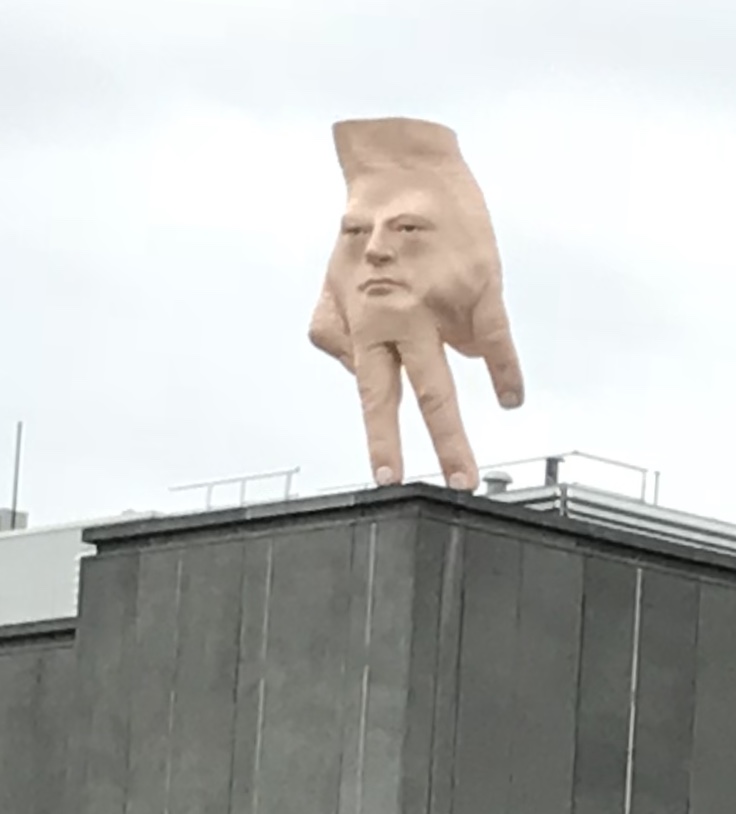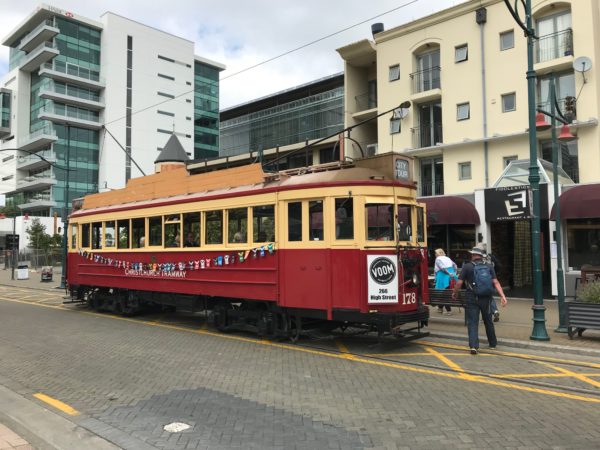
22 Nov TIO NZ: Christchurch, A Story for Thanksgiving
Clint and I will not be doing the Turkey Trot this year, will not be breaking bread or pulling skeletons out of closets around the Thanksgiving table. But still, on November 23rd, our plates will be full – most likely, but with French bistro fare from Bistro Gentil in Wanaka, New Zealand, our current stop. Already our cup runneth over. Already we are grateful – for each other, for our wonderful family and friends, for the little miracles that seem to happen everyday of our life together. One of those “little miracles” occurred recently on our trip. It happened in Christchurch, where our story is centered around our digs, the quietly elegant Hotel Montreal.

Hotel Montreal, (back of the building from the parking lot.) The front of the hotel sits so quietly on the street it could easily be missed.
Prologue (or what we did in town):
The prelude to that story is just the basics: a brief overview of what we did on our short visit to the South Island’s largest city.
The cab driver who picked us up at the airport spoke only broken English, but he did manage to mention a horse race. Like six times. The day we arrived in town, Saturday, was the last chance to catch the happening.
Local intel.
Carpe diem.
Turns out what the man was talking about was New Zealand’s Cup & Show Week, one of the most glamorous and highly anticipated social events on Canterbury’s calendar, a celebration of horse power, fashion, food, the whole nine.

Christ Church, last day, Cup & Show Week.
The race was our first stop in town. Our hotel tried to book us in the poshy members section, but the venue was already sold out, so we sat in the bleachers and cheered along with the crowd. Sat next to a man named Arthur who owned horse #3 in the 10th race. He shared his bets with us. But Lady Luck must have been taking a powder: neither his horse nor his bets came through.

Crowd scene at the races.
Where were you when we needed you Sky Masterson?
Next day, Sunday, we took the TranzAlpine Train to explore the South Island’s majestic mountains, the highest of the Southern Alps, and the vast Canterbury Plains, to learn something about the region’s rich history: settlers, geology, wildlife. The trip from Christchurch to Greymouth on Kiwi Rails is widely considered one of the “Great Journeys” of New Zealand.

Arthur’s Pass

TranzAlpine Train, nearing the summit…
(See Clint Viebrock’s post for details.)
That left just one day to explore before we were scheduled to head further south to picturesque Lake Tekapo, then Wanaka.
Christchurch is the South Island’s largest city, was planned by the Church of England to attract a better class of colonist, the model based on England’s class society. But the scruffy early settlements where laborers and artisans lived soon became grand themselves. Fine parks and neoclassical buildings soon graced the emerging city.
But in 2010 and 2011, it all came tumbling down.
Christchurch was hit by a series of devastating quakes. The epicenter of the second quake was so close to the surface, the damage it caused was the worst in recorded quake history – or about $50 billion smackers.
About 70 percent of the buildings in town were destroyed; about 1400 structures had to be demolished. Much of the city’s infrastructure was wrecked.
Today, while some large bits of Christchurch remain very clean and green, (or very English). But even with some heritage buildings still standing – or about to once again – seven years later, in the wake of the quake, diggers are still rattling about the city’s gridded streets, a constant reminder of how far there still is to go to recreate all that was once there.
Still the view from the Tram Tour, a must, was impressive and encouraging: Massive restoration efforts on some of the historical structures are underway. Space-age new constructions designed with quake-proof infrastructures are eye-popping edifices of the future that are right now in Christchurch.

Even more than Napier – read more about that stop on our route here – Christchurch is sure to emerge from the ashes a glorious Phoenix.
One of city’s signature buildings, put up in 2003 (so before the quakes), is the gleaming Christchurch Art Gallery. According to its architect, it survived the tragedy because it was designed as “a frame within a frame,” which isolated its bones from ground movement.

Christchurch state-of-the-art Art Gallery. Gleaming exterior with “wind farm.”

On the roof of the Art Gallery. It is a portrait of the artist – not Melania’s husband – as the tram driver suggested with a wink. Seems no one in NZ much likes vulgarians with short stubby fingers.
The gallery houses a definitive collection of Canterbury artists and a really good selection of 18th- and 19th-century European paintings, including the work of Boudin, Fatin-LaTour, and Hobbema.
Portraits of Maori by the Bohemian artist Gottfried Lindauer, a man-artist intent on righting some of the wrongs of colonialists, are beautiful reflections of his subjects’ inner lives.
The gallery’s “Cass,” (1936), a painting by Rita Angus, depicts a lonely Canterbury rail strip. The flat, primitive, unassuming image was voted “most loved painting” in a poll.

“Cass,” voted most popular painting in New Zealand in a poll. We saw sights that looked exactly like this while traveling the TanzAlpine Train.
We also caught two temporary exhibits at the gallery.
“Yellow Moon” (though October 2018) was anchored by a statement by Van Gogh about the color yellow, the passionate use of which was most evident in his later works such as Vase with Fifteen Sunflowers, 1888 and The Reaper, 1889. Glowing, vivid paintings – many abstract – join surprising sculpture, video and photography.

Yellow Glove, one of featured images in Yellow Moon, many, like this, designed to showcase everyday objects we see but don’t look at. This Pop Art image really popped.
“Yellow Moon” is, well, brilliant.
As was the tribute to kinetic artist, Kiwi Len Lye.

One of the many magical works by Kiwi artist Len Lye, a major figure in 20th century art.
Lye began making his kinetic sculptures in New York in the late 1950s, which he initially described as ’”Tangible Motion Sculptures” to distinguish his creations from those of Alexander Calder whose mobiles were the best known form of moving art at the time.
Lye’s work was not only unlike Calder’s, but also unlike most European kinetic art. The artist rejected geometrical forms and hi-tech control of his work (in the spirit of the Bauhaus or the Constructivist movement). His sculpture was very body-oriented – Lye’s work dances. He emphasized vibration and (oftimes ferocious) energy.
We got to see Lye’s work dance: motion transformed into emotion. Beautiful. Magical. And sadly no longer on view.
But Len Lye’s foundation at the Govett-Brewster Gallery/Len Lye Center in New Plymouth houses all his art. It might be worth a detour to see the work of one of the most innovative artists of the 20th century.
Our Christchurch Thanksgiving story:
The Hotel Montreal sits gently on a quiet street overlooking Cranmer Square at the edge of Hagley Park – which, parenthetically, is almost as big as New York’s iconic Central Park. Victoria Street and New Regent Street with their selection of cafes and night life is just a short walk away. The luxury boutique property filled with polo-centric art – its former (?) owner was passionate about the sport – is an oasis from city bustle, a tranquil place to kick back and chillax.
Exactly what we needed after The Incident.
After Clint lost his wallet the very first evening we arrived in town.
Among the things (like credit cards and money) the wallet contained was Clint’s driver’s license. Mine is expired and we were meant to pick up our next car for the trip further south the following morning.
Game over?
There is nothing in manager Vicki’s training manual that teaches her well-trained, attentive staff what to do should a guest become separated from his wallet, but Ella and Hélène stepped up and told us exactly how to handle the situation: Take a breath, then call the local police, report the loss and ask for a fax with the case number to use to gain sympathy and support with companies like Avis.
Rinse and relax.
Meanwhile Ella, Hélène, Vicki and the rest of her staff, including Cione and Jasmine, wrapped themselves around us like one giant Snoopy blanket.
At this point, let’s remember New Zealand’s national anthem is “No worries mate.”
We were already in Lake Tekapo when the call came through. A cheery policeman told Clint the cabbie had turned in his wallet, contents intact.
Besides renewing our faith in our fellow man, a sentiment often lost in these trying times, our Hollywood ending serves as a reminder that all is never really lost.
Just AWOL.


Sorry, the comment form is closed at this time.